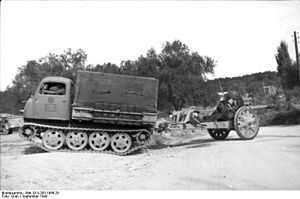Raupenschlepper, Ost
| Raupenschlepper Ost (RSO) | |
|---|---|
|
RSO towing 105 mm howitzer | |
| Type | Prime mover |
| Place of origin |
|
| Specifications | |
| Weight | 2,5-3 t |
| Length | 4.425 m |
| Width | 1.99 m |
| Height | 2.53 m |
| Crew | 2 (including Driver assistant) |
|
| |
| Armor | None |
Main armament | None |
| Engine |
Steyr V8 3.5l / 8-cylinder Petrol/ 85 hp (RSO/01) 5.5l / 4cyl Deutz diesel / 66 hp (RSO/03)66/85 hp |
| Suspension | Fully Tracked |
Operational range | 300 km |
| Speed | 30 km/h (18 mph) |
Raupenschlepper Ost, literally "Caterpillar Tractor East", is more commonly abbreviated to RSO. This fully tracked, lightweight vehicle was conceived in response to the poor performance of wheeled and half-tracked vehicles in the mud and snow during the Wehrmacht's first autumn and winter on the Soviet Front.
The RSO was a contemporary with somewhat similar Allied full-tracked small artillery tractors in use in other armies (such as the Soviet STZ-5 "Stalingradec", and the U.S. Army's own M4 Tractor), mostly originated from the pre-war light to medium series of Vickers artillery tractors.
Two variants of this vehicle were built: the basic cargo carrier, and a self-propelled antitank vehicle armed with a PaK 40 gun. Both shared the same chassis.
Cargo carrier variant: RSO
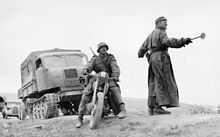
History
After the Wehrmacht's first fall and winter (1941–1942) on the Russian front, they found that the extremely primitive roadways in Russia and seasonal mud required a fully tracked supply vehicle to maintain mobility. Steyr responded by proposing a small, fully tracked vehicle based upon its 1.5-tonne truck (Steyr 1500A light truck) already in use in the army. The vehicle was introduced in 1942 as the Raupenschlepper Ost (RSO).
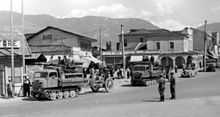
Initially designed as a prime mover and artillery supply vehicle, it eventually served in a wide variety of roles. Immediately after the vehicle reached the Eastern front, the combat units started using it for general transport duties. It gave outstanding service due to its reliability, its ease of maintenance, and its capability to take over a variety of roles - in every kind of terrain - that other vehicles lacked. The four road wheels per side, all in a single line as part of a "slack-track" system with no return rollers, comprised a much simpler suspension system, much more able to handle the rasputitsa mud season and Russian winter conditions, without mud or snow freezing between the wheels of the complex overlapping/interleaved Schachtellaufwerk suspension systems that German half-track vehicles like the SdKfz 7 possessed. Soon the orders for the RSO surpassed Steyr's production ability, and more manufacturers joined the vehicle's production in order to meet the ever increased demands.
Description
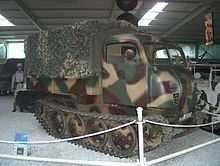
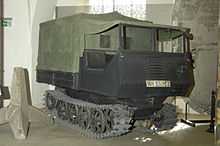
The original version had a pressed-steel cab with a truck-like configuration similar to the wheeled trucks. The next two versions - RSO/02 and 03 - had a simpler, soft-top, slab-sided metal cab. All models had wooden, drop-side cargo beds typical of light trucks of the era. It had an impressive ground clearance for its size of 55 cm and was originally powered by a gasoline Steyr V8 cylinder engine of 3.5 l giving 85 hp, which in the RSO/03 Magirus-produced vehicles was replaced by a superb (although of lower power -66 hp-) Deutz diesel air-cooled engine.
The later model used a Cletrac-type final drive (instead of the automotive-type differential unit used previously) along with many other improvements. The engine was mounted on the floor of the driving cab with the drive taken through a single plate clutch to the transmission. The transmission had four forward gears and one reverse. The suspension consisted of four large pressed-steel disk wheels on each side, mounted in pairs with elliptic springs. Steering involved upright steering levers to four hydraulic brakes on the sprockets and idlers. A spring-loaded pintle was fitted at the rear, and towing hooks were fitted in the front. It had a speed of about 30 km/h.
Anti-tank variant: RSO/PaK 40

History
By 1943 infantry anti-tank units at the front complained strongly that it was almost impossible to move their guns using trucks at daylight under enemy fire, leading to enormous losses of equipment during emergency relocations (at the time a euphemism for withdrawal), and their opinions reached the top ranks. OKW explored a previously considered proposal to fit the 7.5 cm PaK 40/1 anti-tank gun - by then the standard Pak used by the Wehrmacht - on top of an RSO chassis. After seeing the blueprints, Hitler ordered a limited production run for combat testing, before the prototypes were completed.
The project was carried out by Steyr. The suspension of the RSO remained unchanged, but the front driver's compartment was replaced with a low, lightly armoured superstructure. The result was a lightweight, cheap to produce, and highly mobile infantry anti-tank weapon. It was more exposed compared to the conventional panzerjagers which had a construction cost many times that of a RSO/PaK 40.
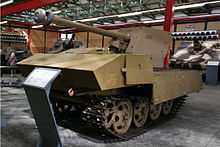
Although the vehicle was intended for use by the infantry anti-tank units, all pre-production vehicles were issued to armoured units (Panzer Jager Abteilungen 743 and 744, and 18th Panzergrenadier Division), due to the urgent need for replacements. Their low speed and light armour inevitably resulted in problems for these units trying to cooperate with those in other fighting vehicles. The German Army Group South, where the units issued for combat testing, declared the vehicle useful, and large-scale production was quickly authorised.
Despite the decision to have Steyr shift its entire production line into RSO/Pak 40, no specific order reached industry, and only the approximately 60 pre-production vehicles were ever manufactured. While the first vehicles were rolled out from the production line, Steyr started testing an improved version that incorporated a wider chassis and tracks; these changes improved cross-country performance and lowered the center of gravity, an issue in a vehicle of such a high ground clearance.
None of the improved version ever reached the front. In October 1943, Steyr was ordered by the Ministry of Munitions to cease production of any type of tracked vehicles. By then a new up-gunned version of the widened chassis had been designed and was planned to enter production in 1944; it had a more powerful and less noisy V8 petrol engine to carry the 88mm Pak 43 L71 gun, by far the most powerful anti-tank weapon of its era designated PzJag K43. It is doubtful if any had been constructed by the end of the war.
Production
Approximately 23,000 RSO of all versions were produced by Steyr (2,600 pcs), Klöckner-Humboldt-Deutz AG (KHD; 12,500 pcs), Auto Union - Siegmar plant (former Wanderer; 5,600 pcs) and Gräf & Stift (4,500 pcs).
See also
- M29 Weasel
- Schwere Wehrmachtschlepper
- SdKfz 4
- Universal Carrier
References
Notes
External links
| Wikimedia Commons has media related to Raupenschlepper Ost. |
- Raupenschlepper OST Steyr (Catalog of Enemy Ordnance, U.S. Office of Chief of Ordnance, 1945)
- HyperScale Raupenschlepper Ost Reference
| ||||||||||||||||||||||||||||||||||||||||||||||
